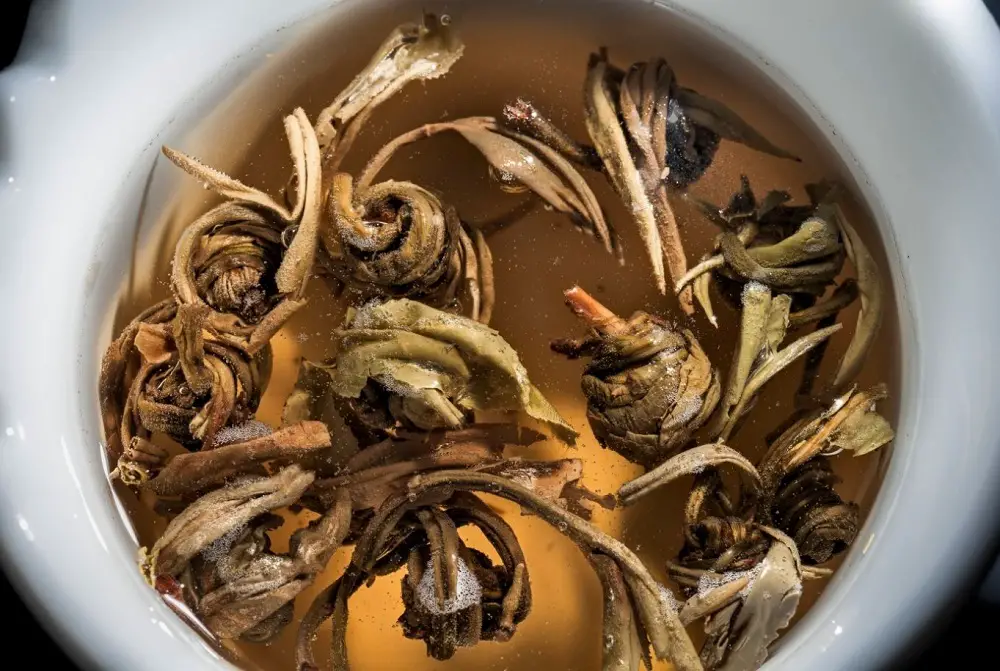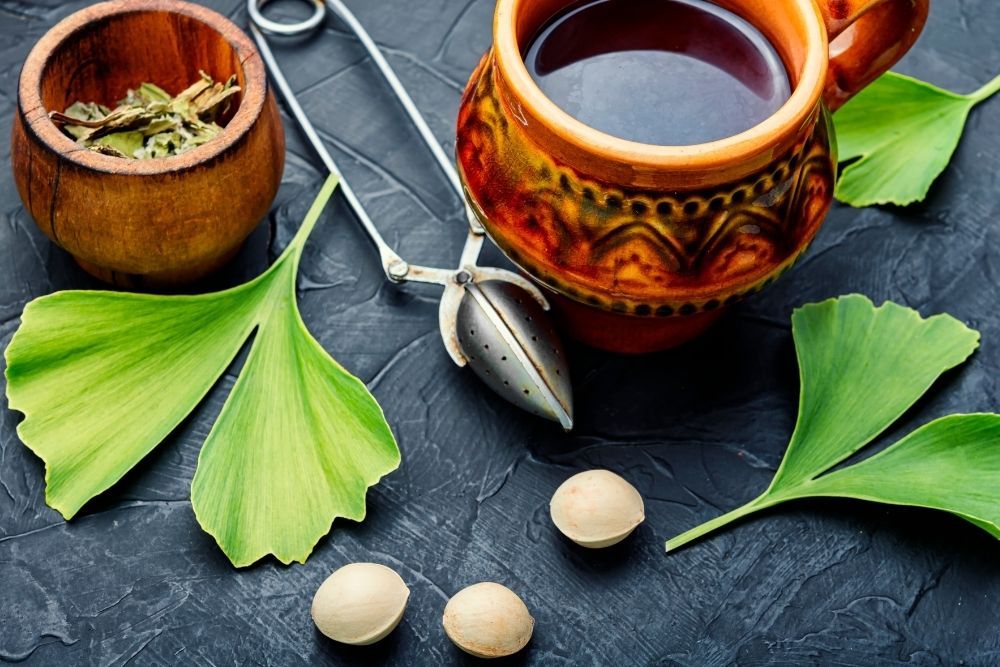Traditional Chinese medicine has long used a variety of herbs and plants to heal a whole host of conditions. We have rounded up a selection of the best herbal treatments to use for acne.
These can be applied topically to the affected areas of skin or can be consumed as teas, or in food. As with any major lifestyle change, if you have any concerns we strongly advise consulting a doctor, dermatologist, or licensed Chinese medicine practitioner.
Ashwagandha

Ashwagandha contains an active compound known as withanolides. These work in the body to flush out impurities, dirt, and toxins. This can improve overall skin health and appearance.
It is also highly moisturizing as it promotes the production of a compound called hyaluronan. This is used to hydrate your skin and prevent it from drying out.
Jin Yin Hua
This is also referred to as a honeysuckle flower. It has numerous uses within the field of traditional Chinese medicine. The flower is aesthetically pleasing, sweet, and has a pleasant smell. It has a huge number of anti-inflammatory and antibiotic properties which keep your skin in optimal health.
The dried flower bud is the medicinal element used to treat acne. It has cooling properties which allows the healing properties to rise through the body, clearing excess heat in its path. Some of this heat is caused by toxins, which in turn, lead to acne.
Jin Yin Hua is commonly found in face creams. It is advised that you wash your face regularly with topical Jin Yin Hua facial cleansers and use topical creams afterward.
Calendula

This is sometimes called pot marigold, as they both originate from the same plant species. It is an incredibly potent plant and has long been an established cosmetic and medicinal plant.
It is packed full of antioxidants and will do a highly effective job of protecting your cells from free radical damage.
There are also high levels of flavonoids in calendula. This is a powerful anti-inflammatory and will have overwhelmingly positive effects on your acne.
Calendula can be applied topically in the form of lotions and creams. Alternatively, you can take it as an oral supplement.
Huang qi
This is also known as Astragalus root and milk vetch. It is a type of bean that has been a staple in traditional Chinese medicine for centuries. It is believed to treat acne by boosting the body’s natural immunity. It is also believed to aid with digestion and clean the liver and kidneys.
There are a lot of flavonoids in this plant which help to protect the cells of your body against damage caused by free radicals. Huang qi also has a lot of amino acids that stimulate collagen production in the body, which is believed to help treat acne.
To take huang qi, it is recommended to apply a topical cream or by steeping the root in hot water to brew a tea.
Zhen Zhu

This is also known as crushed pearl powder. It is a very popular dermatological treatment method for, particularly stubborn acne outbreaks.
The pearls contain 18 different amino acids as well as multiple minerals responsible for skin health. The amino acids help to support the production of collagen, which in turn keeps your skin clear and vibrant.
Zhen Zhu is believed to help keep your skin looking youthful and vibrant at all ages. You can ingest this substance and it is believed to remove toxins from the bloodstream that cause acne.
This can also help to reduce other dermatological conditions such as rashes and itching. It is also believed to nourish the heart and calm the spirit.
Schizandra berry
This is also known as youth berry, Wu Wei Zi, and magnolia vine. It is a woody vine plant native to China, Russia, and Manchuria. The berries of this plant are a bright scarlet red and have been used for medicinal benefits for more than 2,000 years.
Chinese medical practitioners believe that this berry can balance the energy meridians in the body. The berries contain lots of vitamins E and C, making it ideal for the protection and overall health of your skin.
The berry is strongly astringent and promotes the retention of moisture in your skin. This helps your face to appear more beautiful and full. It is also believed to help keep your appearance youthful. There is some evidence that the berry can protect your skin from UVB damage in the sun.
This berry is full of antioxidants, preventing free radical damage and reducing inflammation. It can also release leukocytes in the body. These are anti-inflammatory compounds that can repair and improve your tissues.
Raw honey
Honey has several antibacterial and antifungal properties. Raw honey can help to detoxify your liver and flush harmful toxins out of your body. There are a couple of easy ways that you can take it for acne. The first is by adding a couple of spoonfuls to a large glass of water and drinking this once a day.
Alternatively, apply a thin layer of honey all over the skin of your face and allow it to sit and sleep in for a little while. You could even use raw honey as a base for a mask.
Combine some of the other herbs mentioned in this article for an acne-busting, all-natural face mask. Allow it to sit on your face for 20 minutes before washing off.
Dang gui

This is also sometimes referred to as female ginseng for its role in the support of female health. It is an extract from the Angelica sinensis plant roots. The extract contains compounds that are similar in function to estrogen.
This helps to reduce the levels of androgen hormones in your body, the ones that are responsible for the generation of acne. You must be careful when taking dang gui as it will make your skin more photosensitive, meaning it can sustain damage from the sun much more easily.
You should only take small quantities of this supplement, and it should only be taken under the guidance and direction of your traditional Chinese medicine practitioner.
Gan Cao
This is also known as licorice root. A lot of the principles of Chinese medicine involve the balance of heat and other elements throughout the body. For more information on this, see our article on the 5 elements of life.
Licorice root is believed to remove excess fire from the body that has built as a result of toxins accumulating. It can also inhibit sebum production, one of the leading causes of acne.
Licorice root can be taken in the form of a tea or as a topical ointment applied directly onto the skin.
Turmeric
A turmeric face mask is a great way to reduce the appearance of acne. There have been numerous studies that prove the effectiveness of turmeric to improve skin health, both as a topical and oral supplement.
This is believed to be because turmeric has powerful anti-inflammatory and anti-bacterial properties. It is suggested that the effectiveness of turmeric is increased when it is combined with lauric acid.
Turmeric contains an active component known as curcumin. This can interact with some medicines and is not recommended for consumption for people with gallbladder disease.
You may also expereince an allergic reaction to curcuimin if using turmeric to make a face mask. If you have any concerns about curcumin and your health, consult a doctor or dermatologist for more advice before using it.
Other remedies
Mung beans
These are full of fiber, antioxidants, proteins, and phytonutrients. All of these components are known to protect your body against free radical damage.
They can be eaten as part of a meal or you can blend them to use as a face mask. This will reduce inflammation, puffy skin, and promote healing of acne scarring.
Traditional Chinese medicine has long used a variety of herbs and plants to heal a whole host of conditions. We have rounded up a selection of the best herbal treatments to use for acne.
These can be applied topically to the affected areas of skin or can be consumed as teas, or in food. As with any major lifestyle change, if you have any concerns we strongly advise consulting a doctor, dermatologist, or licensed Chinese medicine practitioner.

Try our Anti-Aging Gua Sha Tool designed to bring out your skin’s natural glow.
Best Gua Sha Product- Anti-Aging: The tool is designed to target 11 specific aging signs such as wrinkles and sagging skin. By following the 7-step routine, users can improve skin firmness and reduce fine lines naturally.
- Enhances Skincare Routine: It works effectively with serums and lotions, boosting absorption and efficacy of skincare products.
- Visible Skin Improvement: Users can expect a smoother complexion, reduced puffiness, and a more youthful appearance.
 P. Sze
P. Sze 














